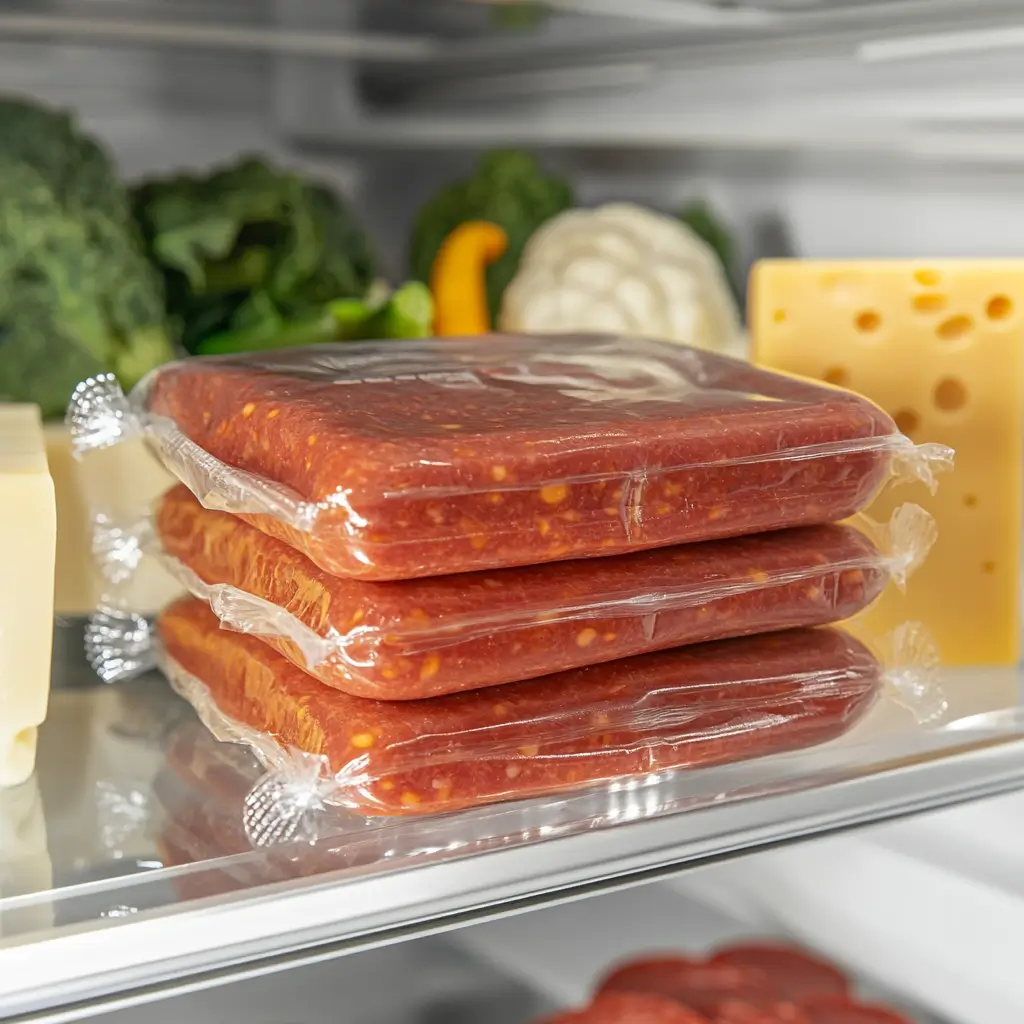
Introduction
If you love the rich, smoky flavor of pepperoni but prefer a pork-free option, beef pepperoni might be your new favorite topping. This delicious cured meat is perfect for pizza, sandwiches, and even snacking. But what exactly is beef pepperoni? How is it made, and is it healthier than the traditional pork version?
In this article, we’ll dive deep into everything you need to know about beef pepperoni—from its ingredients and preparation process to the best brands and how to store it properly. Whether you’re a foodie, a health-conscious eater, or just someone who enjoys great-tasting meat, this guide will answer all your questions.
Now, let’s start by understanding what beef pepperoni is and how it differs from other types of pepperoni.
Part 1: What is Beef Pepperoni?
Definition and Origin
Beef pepperoni is a type of cured meat made exclusively from beef, unlike traditional pepperoni, which is often a mix of pork and beef. It has the same spicy, smoky, and slightly tangy taste as regular pepperoni but with a richer, meatier texture.
Pepperoni itself originated from Italian-American cuisine, drawing inspiration from spicy salamis found in Italy. However, beef pepperoni became popular as a halal or kosher alternative, catering to dietary restrictions while maintaining the bold flavor people love.
Part 2: Ingredients and How Beef Pepperoni is Made

Key Ingredients in Beef Pepperoni
The secret behind the bold, smoky flavor of beef pepperoni lies in its carefully selected ingredients. Unlike traditional pepperoni, which combines pork and beef, this variety is made exclusively from high-quality beef. Here’s what goes into making it:
- Beef: The primary ingredient, providing a rich, meaty taste.
- Spices: Paprika, black pepper, and red chili flakes add heat and depth.
- Garlic and Onion Powder: Enhance the savory profile.
- Salt and Curing Agents: Preserve the meat and give it its signature texture.
- Natural or Artificial Casings: Hold everything together in a uniform shape.
These ingredients work together to create the bold, tangy flavor that makes beef pepperoni irresistible.
Step-by-Step Process of Making Beef Pepperoni
Making beef pepperoni involves a precise curing and drying process. Here’s how it’s done:
- Grinding the Beef: The meat is finely ground to ensure a smooth texture.
- Mixing the Spices: Paprika, garlic powder, salt, and curing agents are blended in.
- Stuffing the Mixture: The seasoned beef is packed into casings to form the traditional pepperoni shape.
- Curing: The sausages are hung in a temperature-controlled environment to develop their flavor.
- Drying and Smoking: Some beef pepperoni varieties are smoked for a richer taste, while others are air-dried.
Want to learn more about the flavor profile of beef pepperoni? Check out this detailed breakdown: What Does Beef Pepperoni Taste Like?
Preservatives and Additives: What You Should Know
Many commercial beef pepperoni brands use preservatives like sodium nitrate to prevent bacterial growth and extend shelf life. However, if you prefer a cleaner option, look for nitrate-free, organic, or minimally processed beef pepperoni.
Part 3: Popular Uses of Beef Pepperoni
Beef Pepperoni in Pizza and Pasta
The most common way to enjoy beef pepperoni is on a sizzling pizza! Whether layered on a classic Margherita or paired with mushrooms and olives, this flavorful meat adds a satisfying punch.
But pizza isn’t the only way to use it. Here are some mouthwatering ideas:
- Pepperoni Pasta Bake: A cheesy pasta dish with spicy beef pepperoni slices.
- Stuffed Peppers: Fill bell peppers with a mix of rice, cheese, and chopped pepperoni.
- Pepperoni Mac & Cheese: Add crispy beef pepperoni bits to your favorite mac and cheese recipe.
Looking for another comforting beef dish? Check out this Slow Cooker Ranch Beef Chops Recipe for more inspiration!
Using Beef Pepperoni in Snacks and Sandwiches
Beef pepperoni isn’t just for cooked meals—it’s a fantastic snack on its own! Try these quick and easy ways to enjoy it:
- Charcuterie Boards: Pair sliced pepperoni with cheese, nuts, and crackers.
- Pepperoni Wraps: Roll beef pepperoni with cheese and lettuce in a tortilla.
- Grilled Cheese Upgrade: Add crispy pepperoni to your grilled cheese for extra flavor.
Creative Recipes with Beef Pepperoni
Thinking outside the box? Here are some unconventional yet delicious ways to use beef pepperoni:
- Beef Pepperoni Omelet: Start your morning with eggs, cheese, and diced pepperoni.
- Stuffed Mushrooms: Fill mushroom caps with cream cheese and chopped pepperoni.
- Beef Pepperoni Tacos: Replace traditional beef with crispy pepperoni for a smoky twist.
Whether on a pizza, in pasta, or as a snack, beef pepperoni is a versatile ingredient that brings bold flavor to any meal.
Part 4: Best Beef Pepperoni Brands to Try
Top-Rated Beef Pepperoni Brands
When it comes to choosing the best beef pepperoni, quality matters. Some brands use premium beef and natural spices, while others focus on affordability. Here are some of the best-rated options:
- Nema Beef Pepperoni – A popular halal-certified option with bold, smoky flavors.
- Boar’s Head Beef Pepperoni – Known for its rich, authentic taste without fillers.
- Applegate Natural Uncured Beef Pepperoni – A nitrate-free, organic choice for health-conscious eaters.
- Bridgford Beef Pepperoni – A budget-friendly option with great texture.
- Foustman’s Beef Pepperoni – A small-batch, artisan brand with a unique smoky kick.
Each of these brands offers a slightly different take on beef pepperoni, so it’s worth trying a few to find your favorite!
Where to Buy the Best Beef Pepperoni
You can find beef pepperoni at most grocery stores, but for premium options, consider these sources:
- Online Retailers – Amazon, Walmart, and specialty food stores offer a wide selection.
- Local Butcher Shops – Some butchers make high-quality, preservative-free beef pepperoni.
- International or Halal Markets – These stores often carry unique brands not found in mainstream supermarkets.
If you want to understand the full range of flavors that beef pepperoni can offer, check out this article: What Does Beef Pepperoni Taste Like?
Part 5: How to Store and Preserve Beef Pepperoni

Refrigeration vs. Freezing: What’s Best?
Proper storage is key to keeping beef pepperoni fresh and flavorful. Since it is a cured meat, it has a longer shelf life than fresh beef, but storage conditions still matter.
- Unopened beef pepperoni can be stored at room temperature if it is vacuum-sealed and in a cool, dry place. However, once opened, it should be refrigerated.
- Refrigeration: Keep sliced or opened beef pepperoni in an airtight container or resealable bag. It lasts 2 to 3 weeks in the fridge.
- Freezing: For long-term storage, freeze it in portion-sized bags. It can stay fresh for up to 6 months when frozen properly.
Shelf Life and Storage Tips
To make sure your beef pepperoni stays fresh:
- Use airtight packaging to prevent moisture from affecting the texture.
- Label the storage date so you know when to use it.
- Avoid exposure to heat and light, as they can spoil the spices and oils.
If you notice a sour smell, slimy texture, or discoloration, it’s time to toss it!
Part 6: FAQs About Beef Pepperoni
Is beef pepperoni halal?
Yes, beef pepperoni can be halal if it is made from halal-certified beef and processed according to Islamic dietary laws. Many brands specifically label their products as halal, so check the packaging.
What does beef pepperoni taste like?
Beef pepperoni has a rich, smoky, and slightly spicy flavor. It’s meatier and firmer than pork pepperoni, with a bold taste that pairs well with cheese and sauces. Want a detailed breakdown? Read more here: What Does Beef Pepperoni Taste Like?
Can you cook beef pepperoni at home?
Absolutely! Making homemade beef pepperoni requires ground beef, spices, and a curing process. You can either bake, smoke, or air-dry it, depending on your preference.
How is beef pepperoni different from turkey pepperoni?
The biggest difference is the fat content and texture. Beef pepperoni is richer and has a stronger flavor, while turkey pepperoni is leaner and has a softer bite.
